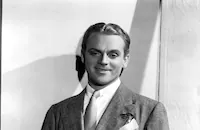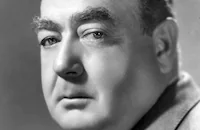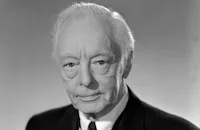The Bride Came C.O.D.

Brief Synopsis
Cast & Crew
William Keighley
James Cagney
Bette Davis
Stuart Erwin
Eugene Pallette
Jack Carson
Film Details
Technical Specs

Synopsis
At the urging of radio gossip broadcaster Tommy Keenan, oil heiress Joan Winfield and band leader Allen Brice decide to elope to Las Vegas. Keenan charters an airplane for the trip from pilot Steve Collins, whose only plane is about to be repossessed by a finance company. Steve is something of a ladies' man but misrepresents himself as a married man and the father of two children in order to remain unattached until he can afford to purchase a fleet of planes. When Joan's father, Lucius K. Winfield, learns of his daughter's pending marriage from Tommy's broadcast, he telephones the airfield to stop the flight. Steve offers to deliver Joan, unwed, to Amarillo, Texas--as far as he can fly without refueling--for ten dollars per pound of her weight, a sum that will enable him to pay his debt. Through a ruse, Steve causes Allen and Tommy to leave the plane and takes off with Joan, explaining to her that she is being kidnapped. Joan offers Steve twice the ransom he is asking if he will take her back to Los Angeles. When he refuses, she attempts to parachute from the plane, but Steve keeps her inside by banking the plane sharply. In the process, the plane is damaged and Steve is forced to land in the desert. Meanwhile, Tommy and Allen board a plane for Amarillo, hoping to intercept Steve and Joan. After spending the night in the desert, Joan spots a town on the horizon and she and Steve investigate. At first, they believe the town of Bonanza is uninhabited, but when they see a plume of smoke, and follow it, they find lone resident Pop Tolliver waiting to cook them breakfast. After Joan signals a search plane, Allen and Lucius rush separately to retrieve her. Unaware of the new developments, Steve locks Joan in the town jail until he can fix his plane. She escapes and, followed closely by Steve, heads for an abandoned mine shaft, where she causes a cave-in that traps them inside. Leaving Joan behind, Steve searches for an escape route and winds up back at Pop's. Pop convinces Steve to keep Joan in the mine until Lucius arrives, but his plans are thwarted when, after Steve admits he is not married and has fallen in love with Joan, she learns that he knows a way out and demands that he free her from the mine. Then Allen and Tommy arrive with a Nevada judge and a flock of reporters. Unknown to them, Bonanza is actually in California, and realizing that this would nullify any marriage performed by a Nevada judge, Steve suggests they perform the marriage ceremony there. Lucius' plane is heard overhead and just when it looks as if everything will work out for Steve, Joan and Allen fly off for Los Angeles. When Joan realizes that her marriage is not legal, however, she happily parachutes out of the plane and lands on a cactus. Her anguished screams bring Steve and Lucius running. Later, Joan and Steve wed and honeymoon with Lucius and Pop in Bonanza.

Director

William Keighley
Cast

James Cagney

Bette Davis

Stuart Erwin

Eugene Pallette

Jack Carson

George Tobias

Harry Davenport

William Frawley

Edward Brophy
Harry Holman
Chick Chandler

Keith Douglas

Herbert Anderson
William Newell
Dewolf Hopper
Creighton Hale
Frank Mayo
George Campeau
Peter Ashley

Jack Mower
Charles Sullivan
Eddy Chandler

Lee Phelps
Tony Hughes
Jean Ames
Alphonse Martell
The Rogers Dancers
George Davis
Peggy Diggins
Mary Brodel
Olaf Hytten

James Flavin
Sam Hayes
Reid Kilpatrick
Garrett Craig
Bob Brossard

John Gallaudet
Sol Gorss
Lester Towne
Claude Wisberg
Richard Clayton
Garland Smith
Victor Zimmerman
William Justice
Cliff Saum
William Forrest
Crew
William Cagney
Kenneth Earl
Julius J. Epstein
Philip G. Epstein
Leo F. Forbstein
Hugo Friedhofer
Ernie Haller
Byron Haskin
Frank Heath
Ray Heindorf
Robert B. Lee
M. M. Musselman
Orry-kelly
Thomas Richards
Ted Smith
Max Steiner
Perc Westmore
Rex Wimpy

Photo Collections
Videos
Movie Clip
Trailer
Hosted Intro




Film Details
Technical Specs

Articles
The Bride Came C.O.D.
Warner Bros. had developed the project for Cagney, who was gradually moving away from gangster roles. He was making the romantic comedy The Strawberry Blonde (1941), and advance word on the film was quite good, so another comedy seemed the perfect choice. Cagney was eager to break into independent production at the time, so he insisted that his brother, William, who was set to be his partner once he went independent, serve as associate producer.
Originally the studio considered a number of established comedic actresses for the female lead. They bypassed the likes of Ann Sheridan, Ginger Rogers and Rosalind Russell, however, in favor of rising star Olivia de Havilland. Then Davis expressed an interest in the part, and Hal Wallis went to bat for her. Both had read critics' complaints that she needed a break from serious dramatic roles. In addition, she was eager to re-team with Cagney, who like her had a history of battles with the Warner Bros. management. They had not worked together since 1934, when they teamed for the minor comedy Jimmy the Gent. Some biographers have suggested that the studio was punishing her with the film because of her notorious temperament, while others have suggested she may have wanted to emulate Katharine Hepburn, who had been equally successful in serious and comic roles. Also possible is that she was drawn to the film's obvious similarities to It Happened One Night (1934), another tale of a runaway heiress saved from a bad marriage by the love of a simple working guy. Director Frank Capra had tried to cast Davis in that film, but Warners didn't want to loan her to another studio on the heels of her loan-out to RKO for Of Human Bondage (1934). Instead, the role had gone to Claudette Colbert, who ended up winning the Best Actress Oscar® most critics think should have gone to Davis for the RKO film.
Any hopes of scoring another It Happened One Night were dashed, however, when production started and the promised re-writes from twin writing partners Julius and Philip Epstein did little to improve the script. Director William Keighley described the atmosphere on the set as funereal. "You should have seen the long faces just before I called 'action' and the sighs of relief when I called 'cut!'" (Keighley quoted in Lawrence J. Quirk, Fasten Your Seatbelts) Nor were matters helped by ten days of location shooting in Death Valley in January. When Cagney complained about the heat, with temperatures climbing to 100 degrees each day, Keighley could only console him that they hadn't shot during the summer, when the highs hit 130.
As for the cactus quills, studio publicity claimed that Davis actually got them by accident when she was told to jump out of Cagney's downed plane into a sand dune that concealed the offending flora. The incident was then added to the script. By other accounts, there was a stunt woman on hand to perform the bit, but when Davis got into the cactus patch for the next part of the scene, she got "quilled" nonetheless. A doctor had to be brought in to remove 45 of the things from the star's stern. Her painful situation got worse a few days later when the script called for Cagney to fire a sling shot at the injured body part.
Although most critics welcomed the comic about face for Davis and Cagney, some were quick to point out that the property itself was hardly up to their talents. The New York Times dismissed it as "a serviceable romp," while Archer Winston in The New York Post pleaded "Okay, Jimmie and Bette. You've had your fling. Now go back to work." More recent fans have looked on the film as one of the low points in both stars' careers, though acknowledging that their first love scene, set in a mine shaft, is a standout for both. Davis would fare better the following year in the more sophisticated comedy of The Man Who Came to Dinner, also written for the screen by the Epstein brothers, while Cagney would have a much better role as a flyer in the wartime drama Captains of the Clouds (also 1942).
Producer: William Cagney, Hall B. Wallis
Director: William Keighley
Screenplay: Julius J. Epstein & Philip G. Epstein
Based on a story by Kenneth Earland & M.M. Musselman
Cinematography: Ernest Haller
Art Direction: Ted Smith
Music: Max Steiner
Principal Cast: James Cagney (Steve Collins), Bette Davis (Joan Winfield), Stuart Erwin (Tommy Keenan), Jack Carson (Allen Bruce), George Tobias (Peewee), Eugene Pallette (Lucius K. Winfield), Harry Davenport (Pop Tolliver), William Frawley (Sheriff McGee), Edward Brophy (Hinkle), William Hopper (Keenan's Pilot).
BW-92m. Closed captioning.
by Frank Miller

The Bride Came C.O.D.
Quotes
Trivia
Notes
A news item in Hollywood Reporter notes that actor Keith Douglas' name was changed by Warner Bros. from Douglas Kennedy to avoid confusion with Arthur Kennedy. News items in Hollywood Reporter add the following information: Ann Sheridan was originally cast in the film, but lost the part because of a dispute with the studio. Cliff Nazarro was tested for a part. Paul Mantz, a noted flyer and stunt pilot is included as a cast member in a Hollywood Reporter production chart. It is probable that Mantz also performed some of the film's flying sequences. Although the Hollywood Reporter review stated that this film marked the first time Bette Davis and James Cagney starred together, they had earlier starred in the 1934 Warner Bros. film Jimmy the Gent. (See AFI Catalog of Feature Films, 1931-40; F3.2218). Bob Hope starred with Hedy Lamarr in a December 29, 1941 Lux Radio Theatre broadcast of the story. Lux Video Theatre produced a version on July 28, 1955.
















